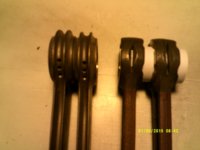OK, spent a lot of time researching and putting this together. Hope it's useful to someone.
I've earned my living for over 20yrs in the motorcycle business in some way or another. I build bicycle frames as a hobby. Motorcycle frames pay the bills...
That's great! Adds to the knowledge pool. You can put information like this in your personal profile. Members are also encouraged to put the year/model/mods of their bike(s) in their signature line. Helps to put troubleshooting issues in proper perspective.
... My comments were sarcastic by nature. With that said.
On XS650 cranks I've rebuild there is a washer either side of the rod on the crank pin. That's a thrust washer...
OK, that clarifies the earlier statement about 'thrust side'. Other threads on engine mods use that term discussing internal dynamics and thought that was the intended meaning.
Yes, the XS650 crankpin uses thrust washers, Yamaha refers to them as 'shims' since they're not under thrust loads. The very early XS1s did not use shims, and the crankshaft was revised mid-1970 to use connecting rod big-end crankpin shims, per this service bulletin.
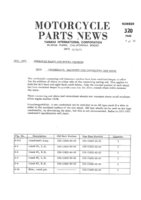
... The spot where that washer sits against on the rod itself has grooves, slots or whatever you'd like to call it you'll see them on the washer surface too. Those "milled out" spots on the bottom of the rod's edge is removed material to reduce rotating weight...
There's a lot of buried engineering data out there on connecting rod design. Took quite a while to grind thru it. Far too much to post here, so will try to summarize.
According to documentation provided by suppliers for 'connecting rod caged needle bearings' receiving splash or vapor (2-stroke) lubrication, in 'big-end regulated' applications, slots and slits are part of the design requirements of the journals for proper lubrication. Having both center slits and edge slots ensures unrestricted oil flow, reducing lubricant stagnation and trap spots where particulates can collect. Here's a snippet from one supplier:
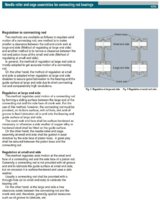
The big-end edge slots are actually part of the forged shape, the sides of the big-end journal are surface-ground to provide a specific width, as can be seen in this pic:
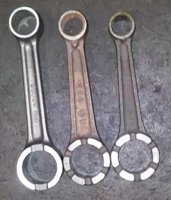
... But, it's known that more contact, surface area, between the rod and pin help reduce wear against increased loads. In cases of bikes that were know to be "lugged" like European models, Japan only models under the CC limit, heavy stop-and goes at low speeds etc. They would try a larger pin, more surface area, then to reduce weight they'd go with a hollow crank pin. Think unsprung weight on an ATV's a-arm. Spindle, wheel etc is unsprung but the frame, rider and engine etc is sprung. Reducing unsprung weight is like adding horsepower...
Actually, it's just part of the overall flywheel mass.
... You see a lot of "Race Motors" with needle bearing lowers from the "old days" that did slice the crank as described...
Back then, we didn't 'slice the crank'. If you mean 'oiling slits' in the big-end journal, the factory connecting rods normally had that feature. Still current practice. If custom/racing connecting rods required them, they could be modified as per this excerpt from Yamaha's racing mods guide, page 18:

... It was mostly due to the increase loads created by the heavy pistons of a "big bore" ported, super size valve train etc. The pistons were made heavy back then and to ensure you didn't have to replace the rod bearing every race they'd slice them...
If you mean the oiling 'slits', in reference to the XS650 connecting rods, they came from the factory with 2 oiling slits.
... The way the link was posted I'd assumed the "553" was a XS650 motor.
Either way. Making people, who can't even weld a hard tail on their XS650, think they can slice a crank free hand with a grinder is really bad. 1. Certain their streetable motor doesn't need it. Loads won't be there...
In that link to Steffis' crankshaft mods, the intention was to direct the OP's attention to the case oil squirters, to ensure that they were indeed properly drilled and clean.
Steffis' mod was to do away with the hollow crankpin and replace it with a solid one of his own design, utilizing more rollers to handle the loading. That eliminated the 533's internal oiling method, seen here.
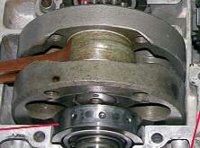
So, he implemented the slits to accomodate the external splash oiling system as used on 256 and 447 connecting rods.
I certainly wouldn't question his credentials in any aspect of metalworking.
... 2. I can't imagine the harm of someone free handing weight out of a crank...
I would refer that to a competent crank builder, like for balancing purposes. The XS650 crank was regarded by many as being 'too light' already. The engine builds for European sidecar racing often show custom cranks that are larger/heavier.
... Remember, they've designed those small slots on the edge of the big pin area to reduce weight...
Here's a couple of pdf's from bearing suppliers that identify those as lubrication slots:
http://www.ntnamericas.com/en/websi...gs/needle_roller_bearings_2300-vii_lowres.pdf
http://www.schaeffler.com/remotemed.../schaeffler_2/tpi/downloads_8/tpi94_de_en.pdf
...A balancing plug weights fall off some race engines and they vibrate. Ask anyone who owned a 96 Honda CR250. I've done....100's of them...
We've seen that here on an XS650 crank, in this thread:
http://www.xs650.com/forum/showthread.php?t=27461
I never overhauled a CR-250 crank. They were still new back then and we didn't experience failures.
... I believe that the rods the OP is using have the slits face forward because they actually gets feed oil under one stroke of the motor. Not each time it passes the sump like people assume. I'd say they have a hole or passage inside the bearing surface that creates a holding bath for the oil till that stroke...
The rear of the connecting rod's big-end sweeps through churning sump oil during the bottom of the stroke, and will receive lubrication during that windage.
The forward oil squirters are in constant spray mode, and will hit the connecting rod's big-end each revolution.
There are no holes or passages inside the 256 and 447 connecting rod big-end journals. The 533 does receive internal oiling from the hollow crankpin's scooped edge.
... I seen A LOT of misinformation about XS650's in general. These PMA kits, aftermarket Carbs "I need more power. Can you rephrase it?" etc
Yeah, that's been going on for a long time in various technical circles, long before the advent of forums, typical. A lot of the knowledgable members here have gone to great lengths to try to straighten that out. The XS650 was Yamaha's first introduction of a 4-stroke motorcycle, and they experienced many teething pains developing it, trying to catch-up and compete in this new market. Many of the things they did back then are known only to insiders and their internal engineering staff and many members here and elsewhere have been hunting/gathering/collecting/posting/publishing info, finding and clarifying the many inconsistencies in various manuals, reverse-engineering undocumented features, trying to solve many of the strange mysteries of this time machine, and find parts support. It's a daunting, but enjoyable hobby to many, a labor of love.
*Whew*

